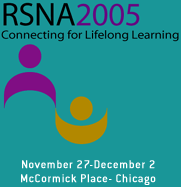
Abstract Archives of the RSNA, 2005
SST13-09
Diagnostic Usefulness of CT Attenuation Coefficient of Urine after Enteral Administration of Iodinated Water (Iohexol) in Neonates with Suspected NEC
Scientific Papers
Presented on December 2, 2005
Presented as part of SST13: Pediatric (Gastrointestinal)
Jeung Hee Moon, Presenter: Nothing to Disclose
Chul Soon Choi MD, Abstract Co-Author: Nothing to Disclose
Dae Young Yoon MD, Abstract Co-Author: Nothing to Disclose
Sang June Park MD, Abstract Co-Author: Nothing to Disclose
Seung Yang, Abstract Co-Author: Nothing to Disclose
To evaluate diagnostic efficacy of increased CT attenuation coefficient of urine after oral administration of iodinated water (Iohexol).
Seventeen neonates (12 males and 5 females) who suspected of NEC were divided into two groups according to clinical signs and radiographic findings. Group II (n=13) was suspected NEC, and Group III (n=5) was definite NEC. Ten normal neonates as group I (control) were also included in this study
First of all, an oral solution of 5mL of iohexol (Omnipaque 300; Nycomed, Princeton, NJ) diluted with 7mL of sterile water. After administration, urine was collected in test tubes at 8 –12 hour intervals, and then CT attenuation coefficient of urine was measured from region of interest that equaled to 50% of the diameter of test tube. Comparative analysis was done using Scheffe test. (p<0.05)
Abdominal radiographic findings of suspected group included persistent dilated and elongated bowel loops whereas those of definite group included intramural air and intra portal vein gas. All neonates in definite group(n=4) were proven to be infected by Rota virus. The average CT attenuation coefficients of each group were 27 11HU (control group), 34 11HU (suspected group) and 76 25HU (definite group). The mean CT attenuation coefficients of definite were higher than suspected or definite groups with statistical significance.
The mean CT attenuation coefficient of urine of definite group was higher from those of control and suspected groups with statistical significance, but no suspected group was statistically different from control group.
Although CT attenuation coefficient of neonate with suspected NEC did not show a statistical difference from the normal neonate, CT attenuation coefficient of urine can be a useful predictor for the progression of NEC with combined used of radiographic findings in patient with NEC and can help in planning of treatment.
Moon, J,
Choi, C,
Yoon, D,
Park, S,
Yang, S,
Diagnostic Usefulness of CT Attenuation Coefficient of Urine after Enteral Administration of Iodinated Water (Iohexol) in Neonates with Suspected NEC. Radiological Society of North America 2005 Scientific Assembly and Annual Meeting, November 27 - December 2, 2005 ,Chicago IL.
http://archive.rsna.org/2005/4416066.html

